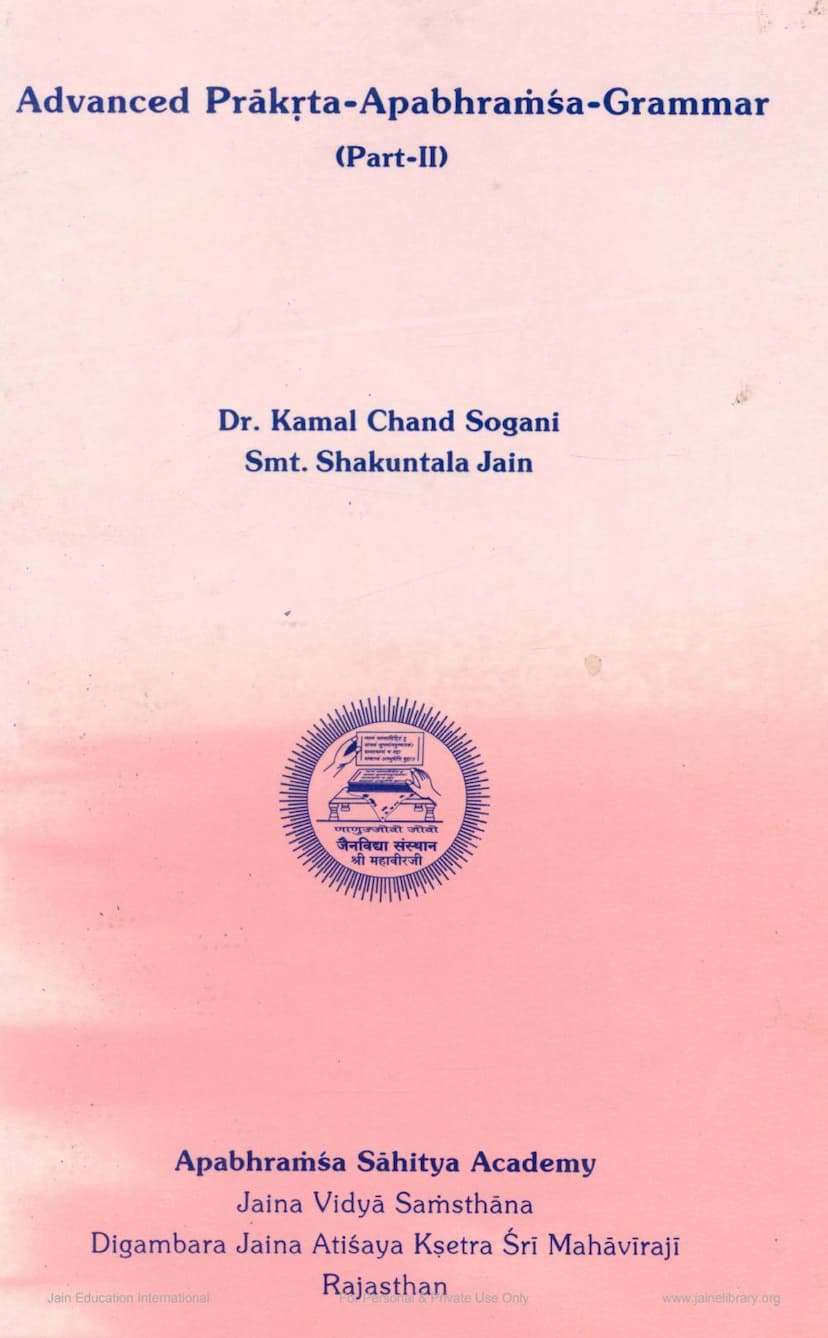Advanced Prakrit Grammar Part 2
Added to library: September 1, 2025

Summary
This document is Advanced Prakrta-Apabhramsa-Grammar (Part-II) by Dr. Kamal Chand Sogani and Smt. Shakuntala Jain, published by Apabhramsa Sahitya Academy. It is an English translation of the Hindi work "Praudha Praksta-Apabhraıśa-Racană Saurabha" Part II.
The book serves as a grammatical guide focusing on the verbs and participles in Prakrit and Apabhramsa languages. It aims to make the understanding of these languages accessible, particularly for those learning through an English medium. The preface highlights the rich history and significance of Prakrit and Apabhramsa, noting their influence on modern Hindi.
The Table of Contents outlines the book's structure:
-
Prelude, Dedication, Introduction: Setting the context and purpose of the book.
-
Lesson 1: Verb-Sūtras: An Introduction: This section begins by acknowledging Acārya Hemacandra's work on Prakrit and Apabhramsa grammar. It explains that the Sutras are in Sanskrit but comprehensible with basic Sanskrit and Hindi/English knowledge. The lesson details the essential grammatical concepts needed for understanding these Sutras, including:
- Persons and Numbers: Three persons (First, Second, Third) and two numbers (Singular, Plural).
- Tenses: Present, Past, Future, Imperative, and Conditional.
- Participles: Absolutive, Infinitive, Present, Past, and Obligatory/Potential.
- Verb Usage: Active Voice, Passive Voice, and Impersonal Forms.
- Suffixes: A comprehensive list of Sanskrit suffixes for various tenses, persons, and numbers is provided, serving as a foundation for understanding the Prakrit and Apabhramsa adaptations.
- Participle Suffixes: Specific suffixes for Past Participle (Kta), Present Participle (Satr, Śānac), Absolutive (Ktva), Infinitive (Tumun), Obligatory/Potential Participle (Tavya, Aniyara), Active/Passive Voice (Kya), and Causative (Nic) are listed.
- Declension: It explains that the declension of words follows patterns similar to Sanskrit, referencing specific Sanskrit nouns like 'Bhubhṛt', 'Rama', 'Hari', 'Guru', 'Stri', 'Gopa', and 'Sarva' for clarity.
- Grammatical Analysis Method: A five-step method for analyzing each sutra is outlined: Combination (Sandhi), Inflection (Vibhakti), Literal Translation, Contextual Translation, and Examples/Notes.
- Verb Conjugation: The book states that verbs ending in 'a', 'ā', and 'o' are conjugated according to models like 'Hasa', 'Thā', and 'Ho' respectively.
- Mathematical Symbols: The use of mathematical symbols for clarification is mentioned, with a reference to an abbreviations list.
- Abbreviations: A list of abbreviations is provided for understanding the Sutras.
-
Section - 1: (i) Prāksta: Verbs and Participles: This section delves into specific Sutras (3/139 to 3/182, 2/146) related to verb formations in Prakrit. It systematically breaks down each sutra, explaining the combination of words, original words, declensions, and providing examples with explanations. Key themes covered include:
- Changes in verb endings for different persons and numbers in the present tense (e.g., suffixes like ti, si, mi, anti, tha, maḥ transforming into Prakrit equivalents like i, e, si, se, mi, nti, nte, ire, itthā, ha, mo, mu, ma).
- The role of specific suffixes like ec, ic, it, ut, et in verb conjugation.
- Rules for the formation of the present tense, imperative, and future tenses.
- The transformation of suffixes related to the verb 'to be' (asa) into atthi.
- Rules for forming causative verbs, including suffixes like ņi, a, e, āva, ave, avi, ada.
- The formation of past participles (kta), passive voice (karma), and impersonal forms (bhāva) using suffixes like luk (zero suffix) and avi.
- The transformation of the initial vowel a to ā in causative forms.
- Rules for forming the absoulute participle (ktvā), infinitive (tumun), and obligatory/potential participle (tavya).
- The change of final vowels in verbs for different tenses and moods.
- Specific rules for the conjugation of Prakrit verbs ending in a, ā, and o.
-
Section - 1: (ii) Sauraseni Prāksta: Verbs and Participles: This section focuses on verb and participle formation in the Sauraseni Prakrit dialect, covering Sutras 4/268, 4/271, and 4/273 to 4/275. It details specific Sauraseni Prakrit rules, such as:
- The transformation of ha into dha in certain contexts (lha, hac).
- The replacement of ktvā suffixes with iya, dūņa, and ttā for the absolutive participle.
- The change of i and e suffixes into di and de in the present tense for certain verb types.
- The use of the future tense suffix ssi followed by present tense suffixes.
-
Section - 1: (iii) Apabhramsa: Verbs and Participles: This part addresses verb and participle formation in Apabhramsa, referencing Sutras 4/382 to 4/388 and 4/438 to 4/442. It highlights Apabhramsa-specific grammatical features:
- Variations in verb endings for persons and numbers, introducing suffixes like him, hi, hu, um, hum.
- Specific rules for the imperative and future tenses in Apabhramsa.
- Transformations of suffixes like tavya, ktvā, and tum in Apabhramsa, introducing forms like ievvaum, evvaum, evā, i, iu, ivi, avi, eppi, eppinu, evi, evinu, evam, ana, anahim.
- The elision of vowels in certain Apabhramsa verb forms.
-
Appendices:
- Appendix-1: Provides conjugation tables for verbs in Prakrit and Apabhramsa, covering present tense, imperative, past tense, and future tense for different verb endings (a, ā, o).
- Appendix-2: Explains the rules of combination (Sandhi) utilized in the Sutras, covering vowel combinations, consonant combinations, and visarga combinations.
- Appendix-3: Offers a summary of the grammatical analysis of the Sutras, detailing the combination rules, inflected/original words, and their declensions or application.
-
Reference Books: A list of 12 reference books on Prakrit and Apabhramsa grammar is provided, indicating the scholarly foundation of the work.
In essence, "Advanced Prakrta-Apabhramsa-Grammar (Part-II)" is a detailed scholarly work that systematically explains the complex verbal conjugations and participle formations in Prakrit and Apabhramsa, offering a valuable resource for students and researchers of these ancient Indian languages.